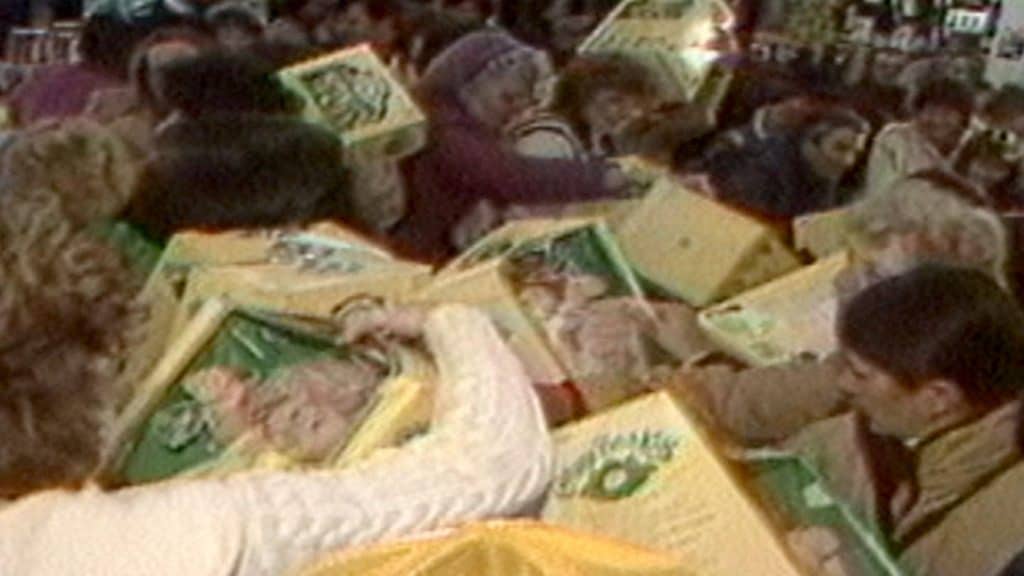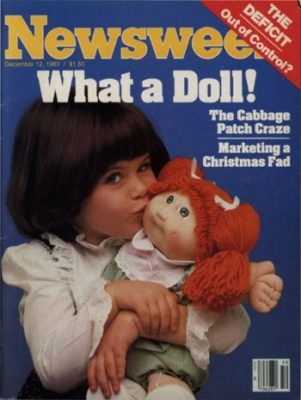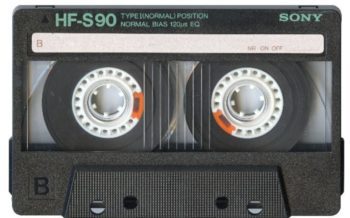
Before Black Friday was a thing, and before other toy crazes like Tickle Me Elmo or Furby, there was one toy craze to rule them all.
The Cabbage Patch Kids riots of 1983 were based around the growing frenzy of the Cabbage Patch Kids. A high demand, mixed with low inventory led to instore riots, trampling, and violence.
There have been some really hot toys over the years that kids want more than life itself. The 80s especially ushered in a whole new era of toys that made kids lose their collective minds. Every year has its hot toy – as mentioned with the Furby, and Tickle Me Elmo – but here a bunch of standouts:
- The Pet Rock
- Beanie Babies
- The Game Boy
- Transformers
- The Rubik’s Cube
- Tamagotchi
- Teddy Ruxpin
- Pogs
- Hatchimals
You need to check out my article to look at the hottest selling toys for each year throughout the 1980s to get a good rundown of all this.
As hot as these toys were, NOTHING compares to the Cabbage Patch Kids craze of 1983. This is going to be a look back at one of the hottest toy crazes of all time and the Cabbage Patch Kids riots that soon followed.
A Quick History On The Cabbage Patch Kids
Before we get to the Cabbage Patch Kid riots, we need to take a quick look back on the dolls that caused this whole ordeal. If you want a full in-depth story check out my article that goes deeper into all things Cabbage Patch.
The Cabbage Patch Kids go back to the 1970s, but that wasn’t their original name: They were called “doll babies.” You may remember the name Xavier Roberts branded right onto the ass cheeks of the Cabbage Patch Kid you owned, but he was not their original creator.
A lady named Martha Nelson Thomas first created the Doll Babies. She wanted to take a new approach with dolls as many of them were not really accessible to be played with. Whether they had porcelain faces or breakable features, they were more to be displayed on a shelf instead of being lovingly played with by a child.
She decided to make her Doll Babies with fabric faces. Not only would this make them durable to be played with, but they also had more infantile-like looks to them as opposed to a porcelain doll that looks like it would come to life in the middle of the night and murder you.
She also had an interesting idea: Instead of just buying the doll from her, you would “adopt” it. That would give more of a sense of ownership to the purchaser. She started selling these new dolls at craft fairs and they were a big hit.
How Xavier Roberts Factors Into This Story
One person who would frequent the craft shows where Thomas would display her dolls was one Xavier Roberts. He was wandering through one of them in 1976 and the Doll Babies caught his eye. He liked the look – and the whole concept of adoption – and would end up buying some to sell at his own shop in Georgia.
Thomas found out that this was happening – and that Roberts was charging a much higher price – and would take back the dolls. He allegedly had said that if he couldn’t sell her dolls he would sell some just like them.
Roberts had a soft sculpture and design background so he recreated the babies so that they could be mass-produced. He started having bulk quantities produced in Hong Kong but they weren’t technically Cabbage Patch Kids yet. He called them “Little People ” but he had already borrowed another idea from Thomas: the idea of adoption.
He came up with the adoption certificate idea and along with that, he created a backstory to the dolls. The story is that when he was ten years old he followed a bumblebee behind a waterfall and was led into a magical cabbage patch. Babies were being born there and he, of course, would dub them “Cabbage Patch Kids.”
This was the 70s so I’m sure there was some “influence” that helped develop this story…
Launching The Cabbage Patch Kids
Before he launched the Cabbage Patch Kids, Roberts made one more smart move; either due to his own sense of guilt – or wanting to avoid the same issue himself – he would brand his own name right onto the little rear ends of the dolls. This was a way to copyright the dolls and avoid counterfeits.
The Cabbage Patch Kids were launched in 1982 and put out by toy company Coleco. Along with the backstory, adoption certificate, and branding, Roberts created one more very valuable feature that may have helped lead to what would become the Cabbage Patch Kids riots:
Instead of making one standard doll – like a Teddy Ruxpin – he would create many different iterations of the concept. They would manufacture 9 different heads to be able to match with various bodies, clothing, and accessories. This created an endless amount of unique dolls meaning that kids were able to find one just for them. They would have a new toy that was special that their friends did not have.
Add this to the unique name and birth certificate and you have a toy that feels custom made for each individual.
What Made The Cabbage Patch Kids Such A Hit?
There are a few things that led to the Cabbage Patch Kids craze but I believe that the last point about the customization of the dolls was the big one. There is no better way to make a person – or kid – feel special than by making them feel unique – and that’s what the Cabbage Patch Kids offered.
The doll you owned was unique to you and no one else would have it. It helps give you more ownership of something and builds more of a connection.
As a kid growing up in the 80s I recognized this appeal to them right away. When you would be looking at a Cabbage Patch Kid in a store you would look through all the different variations to find the one that appealed to you. It’s bizarre but there was a real sense of adoption to the whole process. This is something the Pound Puppies would also follow a few years later.
Instead of just grabbing a coveted toy off the shelf – as people would with a Furby for example – the decision over a Cabbage Patch Kid took time, and thought, and consideration.
So now you’ve got a very unique toy and a series of commercials that really drives home how special and unique these dolls are. This was the 80s and since there were only three networks – and most kids were watching Saturday morning cartoons – there was no way they weren’t going to be aware of this new toy.
They looked cute, they looked fun, special, and you could envision yourself playing with them the same way as the kids in the commercial. Coleco did a good job of making kids see themselves as the kids in the commercials. This way, a child is already invested in the toy as they are already seeing their life with one in it.
So you combine a unique toy, a coveted desire due to the marketing campaign, and combine that with the Christmas season and you’ve created the perfect storm.
The Great Cabbage Patch Kids Riots Of 1983
There’s no surprise here, but if you don’t get your toy out in time for Christmas, you’re going to be pretty up the creek. The Cabbage Patch Kids came out in the fall of 1983 and the demand was already through the roof.
Kids were SCREAMING for these toys and no parent wanted to be the one that didn’t deliver come Christmas time. This is a pretty unique situation as it really was the quality and uniqueness of the toy that drove the craze. There wasn’t any internet, blogs, Amazon reviews, or YouTube videos that could create a false sense of demand for it – kids just genuinely wanted it.
The problem was that Coleco had not anticipated such high demand and that’s where the problems started to begin. Not only had they not anticipated it, but store owners also didn’t either. There are so many new toys released each year that you can’t buy a ton of them – you have to just get an adequate amount to keep your bases covered. So many toys fall by the wayside that you don’t want to be stuck with an excess inventory of them.
So most stores were only stocking 200-500 dolls max.
But the storm was starting to brew…
Again, there weren’t many resources that could drive the hype of a new toy in the 80s. You were pretty much left to commercials and the odd news report. But the demand was growing and people were going out to pick up the hot new toy for Christmas of 1983 and finding out there was only a handful left – or in some cases, none.
The Cabbage Patch Kids Riots Commence
When it comes to a parent trying to provide the best for their children we know that they will stop at nothing. There’s also the competitive aspect to all this: you want to come through, accomplish your goal, and look like the standout parent amongst your peers.
People were snatching them up quickly while others were showing up at stores to find the shelves empty. This would lead them to venture out to another location to find the same issue. Along the way, they were running into other parents who were facing the same problem: “Where can I get a Cabbage Patch Kid?”
By this point, new reports are starting to come out that are doing features on these unique new dolls and how they seem to be the top toy for Christmas of that year. This added fuel to the fire and now the craze moved into full gear.
The other big problem was the media was reporting how few Cabbage Patch Kids seemed to be available. Nothing drives up demand like the idea of scarcity. And this wasn’t fabricated scarcity that a lot of companies do in their marketing campaigns now – there truly wasn’t that many available.
The stores that had stocked 200-500 dolls max were now getting THOUSANDS of customers. When new shipments finally arrived there would be a mad scramble to try and get one. Some stores would only get a dozen or so for hundreds of customers.
Now it gets to the point that people are lining up outside the stores waiting for them to open the same way they would years later on Black Friday. In Charleston, West Virginia, 5000 people showed up at a Hills Department store for only 120 dolls.
And then the violence kicked in.
The Cabbage Patch Kids Riots Are Now In Full Gear
We’re now getting into Lord of the Flies territory here along with angry mobs trying to get their way into the stores. Regular department stores were now having to bring in extra security – and even police – to help appease the crowds.
Some stores were handing out “purchase tickets” to help control the crowds. They would be given out to several hundred customers, but with limited supplies, hundreds were leaving empty-handed – not to mention the hundreds of others without a purchase ticket in the first place. People were now heading to other stores, cities, and even states to try and track one down.
At this point, the news is reporting on the riots which seems to always fuel the mob mentality. People were now trampling, biting, kicking, and clawing to try and get one of the coveted dolls. There were stories of people carrying baseball bats to fight off the others. This wasn’t limited to the customers as store managers were also arming themselves for control and protection.
At this point, I don’t think parents even cared about what it is they were brawling for – they just wanted one for their kid. I don’t think they even knew why they were popular. Non-parents were also seeing the opportunity to get their own and sell them off at exorbitant prices aka Dwight Shurte selling Princess Unicorn dolls on the Office.
Several news reports would interview people saying they didn’t necessarily even like them, they just feel they had to have one.
Coleco just wasn’t able to keep up with the demand and Christmas wasn’t that far off.
Stories From The Front Lines Of The Cabbage Patch Kids Riots
There are a ton of these but some notable ones include Wilkes-Barre in Pennsylvania which ties in nicely to Dwight Shrute. Store managers armed with bats would remark that the shoppers were acting “like crazed maniacs.” Here’s a great report on YouTube from my home country of Canada about the riots.
In Syracuse, New York, new reports would dub it the “Cabbage Patch Massacre” at the Penn-Can Mall. People were being suffocated as the crowds were pushing up against unlocked doors. One lady wrote to the editor that:
“As I was lying on the floor being trampled and calling for help, I feared for my life. I arose stocking footed, face bleeding, and knees badly bruised.”
Mall Santas would have to try and explain to believing kids why there could be the possibility that Santa wouldn’t be able to bring them a Cabbage Patch Kid that year. How do you explain that to a child? Santa didn’t have the magical ability to produce a highly-valued toy during a period of demand, or lacked the foresight to produce larger quantities?
Parents interviewed in news reports were also expressing the same sentiment in not being able to provide for a kid’s wish at Christmas:
“What are we supposed to tell our little girl Christmas morning? What do we say? You’ve been good, but Santa ran short.”
Other outlets were now trying to get in on the action and there was the incident in Milwaukee. Two DJs caused more pandemonium by announcing on the radio that a B-29 bomber was going to drop dozens of Cabbage Patch Kids onto a crowd that was holding up catchers mitts and American Express cards. Dozens of people believed it and showed up at the county stadium in deadly cold conditions. You can go back and read the original article from 1983 here.
Some compared this to Orsen Welles’ War of the Worlds moment and dubbed it “war of the Cabbage Patch Kids World.”
The Riots Finally Calm Down
Like every other toy and product in history, supply eventually caught up and the interest went down. Stores now had hundreds of Cabbage Patch Kids but no customers. Everyone either had lost a limb trying to get one or had sold a kidney to try and buy one on the black market.
Stores had to cut their orders, but that’s not to say they still weren’t selling. They were still huge going into 1984 and even 1985 – but by then there was enough that you could buy one anywhere and at any time. By the end of 1985, they had still made $600 million, but the popularity would really drop after that. In 1986 they would earn just $250 million.
That’s still a huge amount of money during the golden age of toys, but they just couldn’t duplicate the original success.
Coleco would file for bankruptcy in 1988 and Hasbro would take over the rights. In 1994 the rights then went to Mattel. THEN in 2001 Toys R’ Us took over the rights and started producing the dolls until the rights AGAIN switched over to Play Along Toys in 2003. Jakks Pacific would end up acquiring Play Along toys in 2013. But now Cabbage Patch Kids are still being produced by Wicked Cool Toys – who I assume is based out of Boston…
These dolls really get around…
Final Thoughts

Mob mentality always will emerge when a hysteria for anything evolves. The Black Friday riots we are familiar with today seem to have their roots in the Cabbage Patch Kids riots of 1983.
The thing is, this had never happened before and it would be decades until anything like this happened again. It happens every Thanksgiving for regular consumer goods and electronics, but it still hasn’t happened for a toy.
These days it’s people getting trampled for a $29.99 DVD player that they could buy anytime the week before, or after Black Friday.
There have been many toy crazes over the decades, but the Cabbage Patch Kids and the Cabbage Patch Kids riots stand above all of them.



